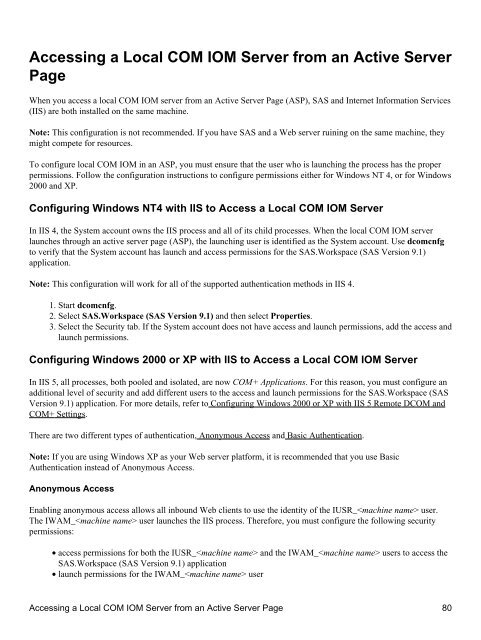SAS® Integration Technologies: Administrator's Guide (LDAP Version)
SAS® Integration Technologies: Administrator's Guide (LDAP Version)
SAS® Integration Technologies: Administrator's Guide (LDAP Version)
You also want an ePaper? Increase the reach of your titles
YUMPU automatically turns print PDFs into web optimized ePapers that Google loves.
Accessing a Local COM IOM Server from an Active Server<br />
Page<br />
When you access a local COM IOM server from an Active Server Page (ASP), SAS and Internet Information Services<br />
(IIS) are both installed on the same machine.<br />
Note: This configuration is not recommended. If you have SAS and a Web server ruining on the same machine, they<br />
might compete for resources.<br />
To configure local COM IOM in an ASP, you must ensure that the user who is launching the process has the proper<br />
permissions. Follow the configuration instructions to configure permissions either for Windows NT 4, or for Windows<br />
2000 and XP.<br />
Configuring Windows NT4 with IIS to Access a Local COM IOM Server<br />
In IIS 4, the System account owns the IIS process and all of its child processes. When the local COM IOM server<br />
launches through an active server page (ASP), the launching user is identified as the System account. Use dcomcnfg<br />
to verify that the System account has launch and access permissions for the SAS.Workspace (SAS <strong>Version</strong> 9.1)<br />
application.<br />
Note: This configuration will work for all of the supported authentication methods in IIS 4.<br />
1. Start dcomcnfg.<br />
2. Select SAS.Workspace (SAS <strong>Version</strong> 9.1) and then select Properties.<br />
3. Select the Security tab. If the System account does not have access and launch permissions, add the access and<br />
launch permissions.<br />
Configuring Windows 2000 or XP with IIS to Access a Local COM IOM Server<br />
In IIS 5, all processes, both pooled and isolated, are now COM+ Applications. For this reason, you must configure an<br />
additional level of security and add different users to the access and launch permissions for the SAS.Workspace (SAS<br />
<strong>Version</strong> 9.1) application. For more details, refer to Configuring Windows 2000 or XP with IIS 5 Remote DCOM and<br />
COM+ Settings.<br />
There are two different types of authentication, Anonymous Access and Basic Authentication.<br />
Note: If you are using Windows XP as your Web server platform, it is recommended that you use Basic<br />
Authentication instead of Anonymous Access.<br />
Anonymous Access<br />
Enabling anonymous access allows all inbound Web clients to use the identity of the IUSR_ user.<br />
The IWAM_ user launches the IIS process. Therefore, you must configure the following security<br />
permissions:<br />
• access permissions for both the IUSR_ and the IWAM_ users to access the<br />
SAS.Workspace (SAS <strong>Version</strong> 9.1) application<br />
• launch permissions for the IWAM_ user<br />
Accessing a Local COM IOM Server from an Active Server Page 80
















